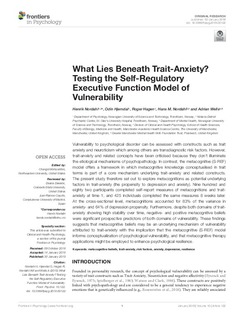| dc.contributor.author | Nordahl, Henrik | |
| dc.contributor.author | Hjemdal, Odin | |
| dc.contributor.author | Hagen, Roger | |
| dc.contributor.author | Nordahl, Hans Morten | |
| dc.contributor.author | Wells, Adrian | |
| dc.date.accessioned | 2019-03-14T10:23:10Z | |
| dc.date.available | 2019-03-14T10:23:10Z | |
| dc.date.created | 2019-01-28T12:45:23Z | |
| dc.date.issued | 2019 | |
| dc.identifier.issn | 1664-1078 | |
| dc.identifier.uri | http://hdl.handle.net/11250/2589987 | |
| dc.description.abstract | Vulnerability to psychological disorder can be assessed with constructs such as trait anxiety and neuroticism which among others are transdiagnostic risk factors. However, trait-anxiety and related concepts have been criticised because they don’t illuminate the etiological mechanisms of psychopathology. In contrast, the metacognitive (S-REF) model offers a framework in which metacognitive knowledge conceptualised in trait terms is part of a core mechanism underlying trait-anxiety and related constructs. The present study therefore set out to explore metacognitions as potential underlying factors in trait-anxiety (the propensity to depression and anxiety). Nine hundred and eighty two participants completed self-report measures of metacognitions and trait-anxiety at time 1, and 425 individuals completed the same measures 8 weeks later. At the cross-sectional level, metacognitions accounted for 83% of the variance in anxiety- and 64% of depression propensity. Furthermore, despite both domains of trait-anxiety showing high stability over time, negative- and positive metacognitive beliefs were significant prospective predictors of both domains of vulnerability. These findings suggests that metacognitive beliefs may be an underlying mechanism of vulnerability attributed to trait-anxiety with the implication that the metacognitive (S-REF) model informs conceptualization of psychological vulnerability, and that metacognitive therapy applications might be employed to enhance psychological resilience. | nb_NO |
| dc.language.iso | eng | nb_NO |
| dc.publisher | Frontiers Media | nb_NO |
| dc.rights | Navngivelse 4.0 Internasjonal | * |
| dc.rights.uri | http://creativecommons.org/licenses/by/4.0/deed.no | * |
| dc.title | What lies beneath trait-anxiety? Testing the Self-regulatory Executive Function Model of Vulnerability | nb_NO |
| dc.type | Journal article | nb_NO |
| dc.type | Peer reviewed | nb_NO |
| dc.description.version | publishedVersion | nb_NO |
| dc.source.journal | Frontiers in Psychology | nb_NO |
| dc.identifier.doi | 10.3389/fpsyg.2019.00122 | |
| dc.identifier.cristin | 1666238 | |
| dc.description.localcode | Copyright © 2019 Nordahl, Hjemdal, Hagen, Nordahl and Wells. This is an openaccess article distributed under the terms of the Creative Commons Attribution License (CC BY) | nb_NO |
| cristin.unitcode | 194,67,40,0 | |
| cristin.unitcode | 194,65,35,0 | |
| cristin.unitname | Institutt for psykologi | |
| cristin.unitname | Institutt for psykisk helse | |
| cristin.ispublished | true | |
| cristin.fulltext | original | |
| cristin.qualitycode | 2 | |

